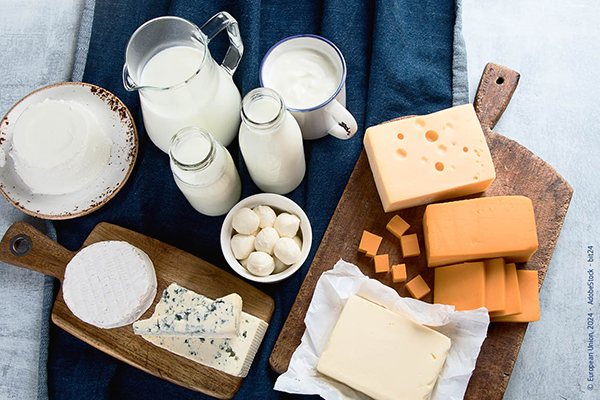Autumn 2023 edition

The adverse weather conditions over the summer continued impacting EU agriculture. These have mixed impacts across the EU as yields of different arable and specialised crops as well as the quality of some products.
At the same time, there have been signs of positive market prospects, as input costs continued declining (e.g. energy, fertilisers, and feed). Lower EU agricultural prices resulted in a further reduction of the EU farmer price index. While processor and consumer price indices resisted this move for some time, they stopped in the last months increasing which could potentially bring some relief to the domestic food demand in the coming months. The recovery in EU exports of some agricultural commodities was supported by more competitive EU prices. This is likely to continue in 2024 as the EUR to USD exchange rate is expected to remain relatively low. On the other hand, the EU market remains attractive for imports.
These issues form the basis for the autumn 2023 edition of the short-term outlook report. Market outlooks are provided for the EU-27. In addition to the short-term outlook, the Commission also publishes a statistical annex. The longer time series of EU balance sheets are available in the Agri-food data portal.
Market fundamentals
Compared to the summer 2023 macroeconomic forecast, the combination of tightened monetary policy and sluggish economic growth has led to a downward revision in economic growth that would affect 2024 as well. Energy inflation continues its decline, but the reduction of supply by OPEC+ countries is bringing an upward price effect on crude oil prices from 2024.
Natural gas prices are increasing towards winter months despite the 90% storage capacity reached in September. Nevertheless, the development of natural gas prices so far improved the affordability of nitrogen fertilisers. Encouraging signs for fertiliser affordability but also availability and some reduction of other input costs continue strengthening farmer margins while EU commodity prices continue declining.
EU processor and consumer price indices started to decline. While the EU food inflation stopped increasing, it remained above general inflation level and at a historically high level. However, monthly food inflation in the EU started to decline in July but prices remain a big concern for consumers, as the cost of living remains elevated, and prices might further evolve in light of the new harvest and uncertain developments in Ukraine.
Lower EU prices of certain commodities observed in past months supported some recovery of EU exports, for example, milk powders. In some other cases, they continue suffering from high global food inflation and lower EU availability, which further pushes prices up for some products (e.g. olive oil, and fruit).
Arable crops
2023/24 EU cereal production is projected at 268.5 million tonnes (4.3% below the 5-year average), mostly due to the adverse weather conditions over spring and summer that affected negatively especially maize and barley production (13% and 7% below the 5-year average). The EU use of cereals is stable compared to the last marketing year, but 1.4% below the 5-year average. Because the overall EU animal production remains relatively stable (but differentiates among species), the increase in the use of cereals for feed is expected to be rather marginal (+0.3%), while the use of cereals for biofuel production continues growing (12% above 2022/23). After a historically high level of EU cereal imports in 2022/23, they are likely to be lower in 2023/24, although still above the 5-year average.
The EU oilseed production in 2023/24 is expected to be at 33 million tonnes (11% above 5-year average), mainly due to an excellent rapeseed harvest (13.3% above 5-year average). With a production of 4.6 million tonnes, protein crops availability will be higher (7.7% above the 5-year average).
2023/24 EU sugar production is forecast at 15.6 million tonnes (close to the 5-year average) as sugar beet planting area, beet yields, and sugar content are expected to increase. EU production of isoglucose, which was estimated to fall by 24% in 2022/23 due to the consequences of the 2022 summer drought, high feedstock, and input costs in main EU producing countries, is expected to partially recover in 2023/24.
Specialised crops
Following the record low EU olive oil production in 2022/23, no full recovery of the production potential due to adverse weather conditions is expected in 2023/24, as it could likely reach only around 1.5 million tonnes. Combined with lower beginning stocks, prices stay at a record high which could continue having negative impacts in 2023/24 on EU exports (-10%) and further reduce EU consumption (-6%).
The EU wine production in 2023/24 could decline as well (around 6%), mainly due to a drop in Italian production which is likely to lose its first position as the largest EU producer to FR. EU consumption of wine could follow its decreasing trend while other uses could grow, supported by crisis distillation. Given this, EU imports will continue declining while EU exports could remain stable, following relatively high volumes traded last year.
Adverse weather conditions could negatively impact EU apple production in 2023/24 (-2.4% year-on-year) and orange production (-2%). In both cases, the reported quality is low, and consequently, more fruit is anticipated to be channelled to processing. In addition, this is driven by still high storage costs. Lower availability of fresh apples and oranges, combined with high consumer prices are likely to push their consumption further down. EU exports of fresh fruit are expected to decline while imports could grow, more in the case of apples which could recover from low levels.
Milk and dairy products
Despite EU raw milk prices continuously declining since the beginning of the year, the EU milk deliveries remain rather stable and are estimated to increase by 0.3% in 2023. Weather conditions have been more favourable than in the challenging 2022, which helps to reduce feed costs and contribute to better feed quality, thereby also increasing the milk solid content of milk (+0.2%) and supporting a 1% increase in milk yield.
While global demand for dairy products is still relatively tight, lower EU dairy prices are expected to support a recovery of some exports, especially of milk powders. EU cheese and whey production are likely to benefit from higher milk availability and competitive prices. In both cases, this could support an increase in EU exports of +1.5% and +4.5%, respectively.
Despite the decreasing dairy cow herd, and assuming normal weather conditions, EU milk supply is forecast to remain relatively stable also in 2024 (+0.2% year-on-year). Although energy and fertilizer prices are over the peak of 2022 and on a decreasing trend, they are still high compared to last years. This, combined with decreasing raw milk prices, still high inflation in the EU and globally, and increasing interest rates, create uncertainty over margins for dairy farmers in 2024.
Meat products
Per capita meat consumption in the EU is expected to go down by 1.5% in 2023 due to price inflation and lower supply on the market.
EU beef production is expected to decrease further in 2023 by -3.1%, mainly due to a structural adjustment in the beef and dairy sector and low margins. EU imports could go down due to low production in the UK, while South America does not fully compensate for losses of imports from the UK. EU exports continue struggling with high domestic prices.
A smaller breeding herd as well as African Swine Fever (ASF) push EU pigmeat production further down by 6.6% in 2023, despite lower feed prices. Sustained domestic demand and lower demand from China slowed down EU exports by 16% in 2023.
EU poultry production could benefit from a recovery of 3.3% in 2023 thanks to being one of the cheaper animal proteins available. On the other hand, EU poultry prices make exports less competitive. Brazil, Ukraine, and Thailand are sending substantial volumes to the EU (+12%), while the UK records a massive decline.
The historically low EU sheep flock pushed slaughterings down by -1.8% in 2023. Sustained demand and high domestic prices favour more imports from New Zealand and the UK (+15% in 2023).
Data
EU balance sheets are available in Agri-food data portal, both in the form of tables and graphs. In addition, selected data for Member States are available and visualised in dataM.


